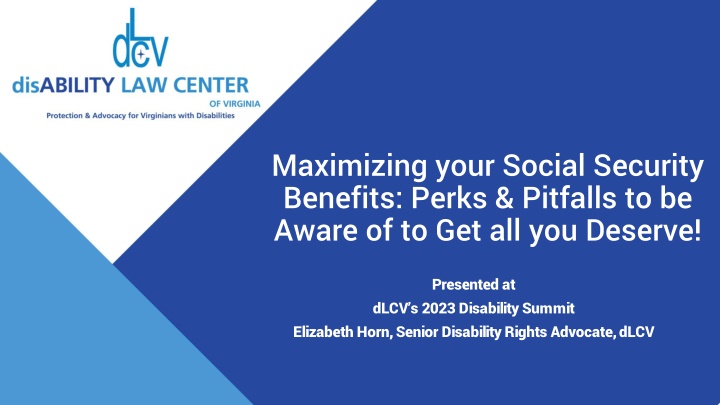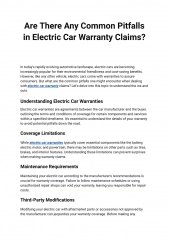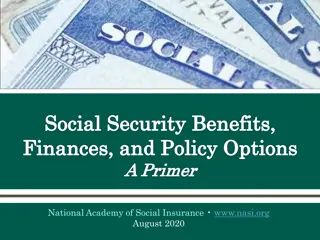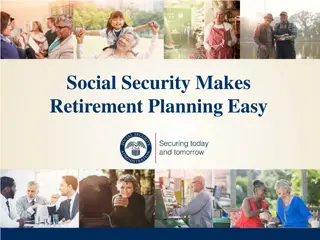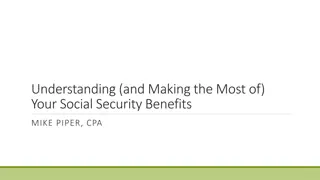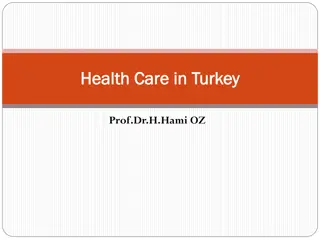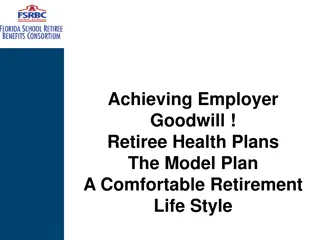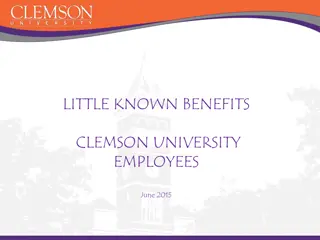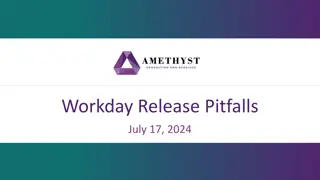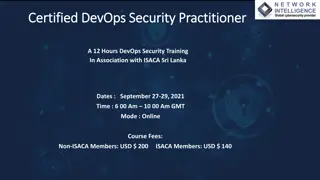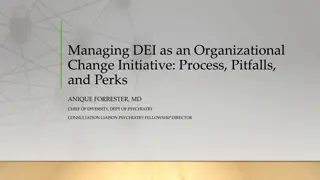Maximizing Social Security Benefits: Perks & Pitfalls for You
Learn about maximizing Social Security benefits, navigating Medicaid and Medicare programs, understanding disability benefits, and avoiding common pitfalls that could affect your benefits. Gain insights into benefit planning and essential considerations when working while receiving benefits.
Download Presentation

Please find below an Image/Link to download the presentation.
The content on the website is provided AS IS for your information and personal use only. It may not be sold, licensed, or shared on other websites without obtaining consent from the author.If you encounter any issues during the download, it is possible that the publisher has removed the file from their server.
You are allowed to download the files provided on this website for personal or commercial use, subject to the condition that they are used lawfully. All files are the property of their respective owners.
The content on the website is provided AS IS for your information and personal use only. It may not be sold, licensed, or shared on other websites without obtaining consent from the author.
E N D
Presentation Transcript
Maximizing your Social Security Benefits: Perks & Pitfalls to be Aware of to Get all you Deserve! Presented at dLCV s 2023 Disability Summit Elizabeth Horn, Senior Disability Rights Advocate, dLCV
ACRONYM SOUP for the SOUL! SSA = Social Security Administration SSDI = Social Security Disability Insurance for workers who are or become disabled; referred to as disability SSI = Supplemental Security Income for individuals who lack credits for SSDI and are low income elderly or disabled. Child SSI is dependent on parental income. Medicare healthcare coverage is for SSDI recipients Medicaid healthcare coverage is for SSI recipients
What you will learn about today. Benefit Perks Medicaid when on SSI Medicare Savings Program when on SSDI Ticket to Work Employment Supports or Work Incentives & the need for benefits planning Disability benefits vs collecting early retirement at 62
Benefit Pitfalls Understanding income and resource limits to avoid an overpayment (parental deeming, spend downs, ABLE accounts, etc.) or a Medicaid termination SSI s 1/3 Reduction when not contributing to the household Neglecting to keep your disability well documented for the review Neglecting to inform SSA of changes (to address, to income/resources, etc.) Neglecting to obtain benefit planning when you decide to work
Benefit Perk #1 - with SSI Medicaid Health Insurance w/home and community supports
SSI + Medicaid All SSI recipients are immediately entitled to FULL Medicaid (but you must apply for it at https://commonhelp.virginia.gov/ or call 833-5CALLVA (TDD: 1-888-221-1590) Includes health care coverage and access to Long Term Support Services (LTSS) and Home and Community Based Waivers Nominal co-pays if any Even $1 of SSI keeps you attached to Medicaid If you remain on a parent s employer health insurance you may qualify for Medicaid s HIPP Program (reimburses cost of premium for family) HIPP: https://www.dmas.virginia.gov/for-members/other-programs-and- guidelines/premium-assistance/health-insurance-premium-program/
Benefit Perk #2 - with SSDI Medicare Health Insurance w/the Medicare Savings Program
SSDI + Medicare All SSDI recipients automatically qualify for Medicare BUT There is a 24 month waiting period before it begins which does not include the 5-month waiting period from the point you are considered disabled. P.S Medicare covers 80% of healthcare costs. A supplement is needed such as Medicaid, Medi-gap or Medicare Advantage.
What about this huge 24+5 month gap in healthcare?? Maintaining health care coverage is crucial to: avoid physical and/or mental decline and to keep your disability documented for a review To cover this healthcare coverage gap you may qualify for the Medicare Savings Program Qualified Medicare Beneficiary
Medicare Savings Program when on SSDI https://www.medicare.gov/medicare-savings-programs SSDI payments less than $1660/month (2023) qualify for Medicare Savings Program. The less your monthly payment the more you qualify for! Please note: The amounts quoted go up each year due to federal cost of living increases.
Medicare Savings Program Tier 1 for SSDI payment below $1235 (2023) Resources below $9090 (2023) Tier 1 Qualified Medicare Beneficiary (QMB) Medicaid pays Medicare Part B premium ($165) Extra Help inexpensive prescription coverage is included you ll pay no more than $4.30/script in 2023 Medicaid pays for Medicare s deductibles, coinsurance, and copayments Medicare + QMB = Full healthcare coverage w/Extra Help and no premiums
Extra perks when you meet QMB When you qualify for QMB you can enroll in a Dual Eligible -Special Needs Plan that provides and coordinates all of your healthcare needs. https://www.dmas.virginia.gov/media/4167/member-dsnp-faq.pdf These plans usually come with additional benefits to include: Dental Healthy Living Card to pay for groceries ($75/month) Over the Counter card to pay for non-prescription medications, hygiene items etc. (may also be used to pay for utilities) $400/quarter Gym memberships
Medicare Savings Program Tier 2 For SSDI payment between $1236 and $1478 (2023) Resources below $9090 (2023) Tier 2 -Specified Low Income Medicare Beneficiary Medicaid pays the Medicare Part B premium ($165) Extra Help inexpensive prescription coverage is included You ll pay no more than $10.35/script in 2023 NOTE -Medicaid coverage is not included in this tier BUT if your income is under $972/mo. (2023) you may qualify for Medicaid. Apply here: https://coverva.dmas.virginia.gov/learn/insurance-for-adults/medicaid-for-persons-who-are-aged-blind- or-disabled-abd/ NOTE -If not, you need to find additional coverage as Medicare alone only covers 80%.
Medicare Savings Program Tier 3 For SSDI payment between $1479 and $1660 (2023)-Resources below $9090 (2023) Tier 3 Qualified Individual Medicaid covers Medicare Part B premium ($165) NOTE -Medicaid coverage and Extra Help are not included in this tier BUT if your income is under $972 (2023) you may qualify for Medicaid. Apply here: https://coverva.dmas.virginia.gov/learn/insurance-for-adults/medicaid-for- persons-who-are-aged-blind-or-disabled-abd/ NOTE -If not, you need to find additional coverage as Medicare alone only covers 80%.
For a secondary healthcare coverage contact VICAP Virginia Insurance Counseling and Assistance Program offers FREE, unbiased, confidential Medicare insurance counseling and assistance for people with Medicare. Apply here for help: https://www.vda.virginia.gov/vicap.htm#:~:text=The%20Virginia%20Insurance%20Counseling %20and,assistance%20for%20people%20with%20Medicare E-mail: Aginginfo@dars.virginia.gov Toll-Free 1-800-552-3402 If you have a hearing or speech impairment, use the free Virginia Relay telephone relay service by dialing Phone icon 7-1-1.
Review dLCVs guide entitled: Do You Have a Disability and Need Healthcare? Do You Have a Disability and Need Healthcare? Go to: www.dlcv.org/socialsecurity
Benefit Perk # 3 Social Security Work Incentives & Employment Supports for SSDI and SSI beneficiaries
Employment Supports Help You Work While Disabled (also known as work incentives) The SSDI and SSI programs include several work incentives designed to protect your cash benefit and healthcare benefits while you test your ability to work. If your benefits end because you start to work and you have to stop working later, work incentives can make it easier to begin receiving benefits again. SSA PUBLICATION -WORKING WHILE DISABLED https://www.ssa.gov/pubs/EN-05-10095.pdf Note: There are work incentives for SSDI beneficiaries only, SSI beneficiaries only and some that are for both.
SSDI employment supports (do not apply to SSI) The SSDI work incentives provide help over a long period of time to allow you to test your ability to work or to continue working. These incentives help you gradually become self-sufficient. In general, you have at least 9 years to test your ability to work. This includes: full cash payments during the first 12 months of work activity; a 36-month re-entitlement period during the extended period of eligibility; and a 5- year period in which SSA can start your cash benefits again without a new application (called Expedited Reinstatement). You may continue to have Medicare coverage during this time or even longer.
SSDI employment supports as you go to work You may continue to have Medicare coverage during this time or even longer. 5-year Expedited Reinstatement 9-month Trial Work Period Keep SSDI + all earnings 36 month Extended Period of Eligibility Each month you fall under limit you keep your benefit, then benefit ends. If you become unable to work again due to same disability your benefit is re- instated without a new application though some documentation is necessary.
SSI employment support if you work Once you receive SSI, your disability payments continue until you medically recover, and meet the income and resources limits. After $85 in exclusions, SSI will be reduced $1 for every $2 you earn (ex. $500 of earnings will reduce your SSI payment by $250.) If your earnings get too high (approx. $1650/month) you may lose SSI payments BUT your eligibility for Medicaid may continue while you are working. In most cases, if you are unable to continue working due to your disability, you can begin receiving payments again without a new application. Again, even $1 of SSI keeps you qualified for Medicaid
Helpful SSDI/SSI employment supports Plan to Achieve Self- Support (PASS) A PASS allows you to set aside other income to pursue a work goal. That income is not counted as a resource or when calculating your SSI payment. The income can be used for education, vocational training, assistive technology, or starting a business. Impairment-Related Work Expenses: SSA deducts the cost of out-of-pocket disability- related services or items you need to work from your SSI earnings or when determining if your work is substantial. Ex. Specialized transportation, service animal costs, medical devices, etc. Subsidies & Special Conditions A subsidyis when support is provided by the employer that results in you receiving more pay than the value of your services. A special condition is support you receive on the job by an agency such as job coaching, etc.
Ticket to Work (TTW) Ticket to Work is a Social Security Administration no-cost, optionalemployment program for Social Security disability beneficiaries between ages 18 and 64 who can and want to work. The program increases your available choices when obtaining employment services, vocational rehabilitation (VR) services, and other support services you may need to get or keep a job. Both SSI and SSDI beneficiaries can sign up for Ticket to Work. DARS clients are enrolled in TTW but you can choose a different employment network (EN) Learn more about TTW and choosing an EN at: https://www.ssa.gov/work/overview.html?tl=0%2C1%2C2
A key benefit to enrolling in Ticket to Work If you are making progress in your TTW program you will not be subject to: .work triggered or ..regularly scheduled medical Continuing Disability Reviews
SSAs REDBOOK The Red Book serves as a general reference source about the employment-related provisions of the Social Security Disability Insurance and the Supplemental Security Income Programs for educators, advocates, rehabilitation professionals, and counselors who serve people with disabilities.
SSA REDBOOK REDBOOK www.ssa.gov/redbook www.ssa.gov/redbook English PDF Version can be printed English HTML Version to view online Spanish PDF Version can be printed To Order Printed Publication, select Order. To Order the Red Book in Alternative Format, select Alternative Format.
Benefit Perk #4 Keeping or obtaining SSDI at 62 vs. collecting retirement
Disability benefits vs collecting early retirement at 62 For those with a work record, your benefit estimate statement* quotes your payments at the following events/ages: Disability (ex. $2000/month) (can occur from age 18 up to your retirement age) 62 (ex. $1500) keep this amount permanently (25% penalty) Or at your FRA (full retirement age) your disability benefit will convert to your full payment (Ex. $2000/month) no penalty to your retirement by collecting disability. SSA s eligibility rules relax at age 50, 55, 60 so it s much easier to be approved. Avoid collecting at 62 in favor of obtaining or continuing disability. *Your SSA MyAccount: www.ssa.gov/myaccount
Benefit Pitfall #1 SSA s one-third reduction to SSI
SSIs One-Third Reduction SSA monthly benefit rate is reduced by one-third when an individual lives throughout a month in another person s household and receives both food and shelter from others living in the household. 2023 SSI rate = $914; with 1/3 reduction = $603 To avoid this reduction, tell SSA during the initial or annual financial screening that you intend to assist with household expenses when you receive income. For more information see dLCV s guide or video on: How to Avoid the One-Third Reduction www.dlcv.org/socialsecurity
Benefit Pitfall #2 Overpayments
How do Overpayments Occur? 1) Failure to report change of address. 2) Increases in earned or unearned income that isn t reported to SSA. 3) Changes in living situation or marital status. 4) Having more resources than the allowable limit. 5) An error in calculating the benefit amount due to incorrect or incomplete information at SSA. 6) SSA error
Changing your address and/or phone # is critical to prevent benefit overpayments or terminations Failure to change address/phone # with SSA = failure to receive important notices with deadlines. This could include: Notice of scheduled financial re-screening Notice of disability or work review SSA depends on you to immediately notify them when you move even if it s an apt # change only.
Understanding SSI income and resource limits to avoid an overpayment For children: SSI eligibility is dependent on parent s income and resources. SSA calls this deeming . https://www.ssa.gov/ssi/text-child-ussi.htm For adults: Resources over $2000 will prevent or terminate SSI https://www.ssa.gov/ssi/text-resources-ussi.htm Adult SSI earned or unearned income can reduce or terminate your payment https://www.ssa.gov/ssi/text-income- ussi.htm#:~:text=Generally%2C%20the%20more%20countable%20income,income%20for%2 0the%20SSI%20program. Key takeaway: SSI payments are affected each month by income and resource changes. SSA must be notified promptly or improper payments can continue and cause an overpayment of benefit. To appeal: https://www.ssa.gov/pubs/EN-05-10098.pdf
Benefit Pitfall # 3 Neglecting to keep your disability well documented for the review
Continuing Disability Reviews (CDRs) CDR s occur every 1, 3, 5 7 years depending on when SSA thinks your condition will improve enough to work. See Notice of Award for the annual review of your benefits. Your disability must be kept documented to prove you remain unable to work gainfully. Continue to see doctors, therapists, etc. regularly and report to them your ongoing limitations-even if there is nothing more they can do for you.
Pitfall # 4 Neglecting to obtain benefits planning when you go to work while receiving a benefit
Why benefits planning? To insure perks and avoid pitfalls! What is benefits planning? Benefits planning can help you: understand the employment supports that are available to you, enable you to make informed decisions maximize your benefits and avoid overpayments. Who does benefits planning in Virginia? Community Work Incentives Coordinators -https://infinityss.org/our- services and Endependence Center in Tidewater, VA: https://endependence.org/services/benefits-counseling/ DARS w/clients who receive SSI and/or SSDI see your counselor!
CONNECT WITH US ADDRESS 1512 Willow Lawn Drive Suite 100 Richmond, VA 23230 PHONE 1-800-552-3962 (toll-free) | 804-225-2042 Spotify Logo Png - Free Transparent PNG Logos Twitter Icon - Royalty-Free GIF - Animated Sticker - Free PNG - Animated Icon Social, media, instagram, circle Free Icon of Social media (color) Icons Facebook icon - Free download on Iconfinder WEBSITE www.dlcv.org GET HELP dLCV.org/get-help dlcv.org/podcast @disAbilityLawVA @disAbilityLawVA facebook.com/ disAbilityLawVA
